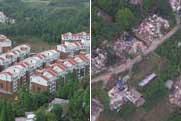China
Increased rail capacity to ease China´s holiday travel strain
Source: Xinhua | 05-02-2009 16:37
BEIJING, May 2 (Xinhua) -- Holiday travel in China usually means long trips and ticket shortages.
This May Day holiday, running from Friday to Sunday, might offer some improvement since China launched a new railway schedule April 1 featuring faster trips and more seats. It was the seventh major overhaul of the rail schedule since 1997.
The Ministry of Railways (MOR) estimated that 23 million trips would be made from April 30 to May 3, up 520,000 from a year earlier.
The new schedule includes 89 new direct trains, bringing the daily total to 1,551 round trips with 10.6 percent more seats.
Some key facts about China's high-speed rail service:
China introduced regular high-speed service in April 2007, with speeds of 200 km per hour or more.
The first inter-city high-speed railway opened last August, the350-km-per-hour Beijing-Tianjin route. It takes only 30 minutes to travel 120 km.
China added two 250-km-per-hour inter-city lines on April 1. One links Hefei, capital of eastern Anhui Province, with Wuhan, in central Hubei Province. The other connects Shijiazhuang in northern Hebei Province with Taiyuan, Shanxi Province. Both lines cut travel time by more than half.
The Beijing-Shanghai high-speed railway, which started construction a year ago, is scheduled to open in 2012. It will halve travel time to about five hours.
Major cities are served by 200 bullet trains, with 600 more expected to be running by 2012.
The MOR plans to expand the 79,000 km network to 120,000 km by 2020.
The country plans to double rail investment to about 600 billion yuan (87.9 billion U.S. dollars) this year, according to the MOR.
Annual railway investment from 2010 to 2012 will be at least 600 billion yuan.
By 2012, China will have 110,000 km of rail lines, of which 13,000 km will be passenger routes with speed at or above 200 km per hour.
By 2020, the total length of railways allowing a speed of more than 200 km per hour will reach 18,000 km.
Editor:Liu Anqi



